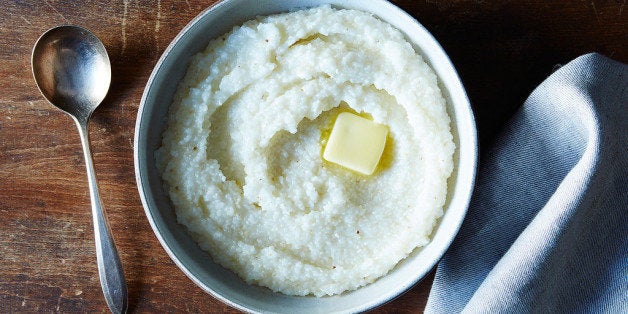
If you're like us, you look to the seasons for what to cook. Get to the market, and we'll show you what to do with your haul.
Today: You're doing grits wrong. Here's how to do them right. (Hint: It will involve some coddling.)
I’d be wise to trust a chef with three restaurants, a marquis spot on an Emmy award-winning show about food, and a glossy, celebrated new book. But when he starts asking a lot of me for only a simple bowl of grits, I start to reflexively push back. You want me to pay attention to the amount of time the corn spends drying in the field, Brock?
The answer is yes, because the dryness of the corn will affect the cooking time. He’d also say that in order to deduce how much water and butter to add to my grits, I must understand the starch and sugar content of my corn. (The grits at my local store aren’t half that self-aware. If they don't know what they are, how am I supposed to?) He’ll mention that the corn is really best right after it’s milled, and he'll warn you not to use tap water. I broke those rules. My corn was milled eons ago, for all I know, and my grits were instead perfumed with the tap terroir of New York City. It’s not spring water from the verdant hills of Appalachia, but I didn’t have time to track that down -- I was too busy watching the corn dry in the field.
And yet: Brock wins. Separate his method from his missive, and you’ll make yourself the best bowl of grits you’ve ever had.
This is, according to him, how to cook grits like a Southerner, and he starts his lecture by shattering everything you thought you knew: that because grits are synonymous with comfort they should also be synonymous with excess. His version is impervious to this kind of transitive relationship. In his world, more doesn’t make them more -- it makes them less. Brock is going to make you practice restraint, which is to say he’s going to request you put away the parade of milk fat you usually call on (milk, cream, cheese).
Pull from your pantry in their stead one lemon, a few bay leaves, and a mess of grits. (I concede that you should find the best ones you can, but failing just-milled, heirloom corn, whatever’s on your shelf will still benefit from this method.) The austerity of this scene, something like a Depression-era still life, will make you feel initially sad. Power through: You have some soaking to do, and this will be your grits’ saving grace.
Submerging the grits in a tub of water for a long soak (at least 6 hours) starts the hydration process in advance of the cooking, which enables the grits to cook faster and hold onto a little more of their corn flavor. Brock is going to give you grits that actually taste like corn, and this is step one. Then you’ll quickly skim for errant hulls and chaff, and dump all of this into a large pot over high heat. The soaking water becomes the cooking water, and that's a good thing, because by this point it's basically eau de corn. But you’re not done mollycoddling: After your large vat of hot corn water boils, you’ll cover it, take it off the heat, and let it “relax” for ten minutes. Newly rested, you can nudge it back over low with a few bay leaves to finish cooking.
Brock calls for you to stir with a silicone spatula, and again your angst will resurface. Up until you decided to try it his way, your grits worldview included only tough love -- hearty, simple food is not the food you’re used to sheltering. Humor him anyway: I fell into a trance gliding mine along the bottom of the pot and then folding the grits back onto themselves in big, swooping half moons. I started to feel relaxed. I might have whispered a sweet nothing. Brock’s poetry was starting to make sense.
And so were his grits: When they’re tender (“shhh, he coos, “they will tell you when they’re done”), you pluck out the bay leaves and stir in a pinch of salt, a squeeze of lemon, and a knob of butter. (Be gentle: A knob does not mean a half a stick.) At this point you’ve given these grits a lot of yourself; you’ve sourced and soaked and stirred and shielded them through the whole cooking process. Now they’re going to give back. Care for them, and they will care for you.
Serve yourself a big bowl of grits that, barely seasoned, taste more like themselves than they ever have. There’s no dairy to muffle the rally cries of the corn you just soaked and slow-cooked. You can almost see the corn field; you can almost taste their starch and sugar content. The bay makes them slightly heady, the lemon, present. If this is how they do it down South, I’m all in.
Lightly adapted from "Heritage"
Serves 6 to 8
2 cups best-quality corn grits
8 cups water
2 to 3 bay leaves (fresh is best)
Kosher salt, to taste
1 lemon
Butter, to taste
Hot sauce (optional, for serving)
Photos by Mark Weinberg
Food52 is a community for people who love food and cooking. Follow them at Food52.com -- and check out their kitchen and home shop, here.